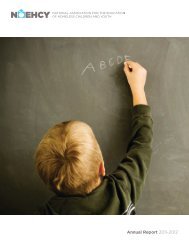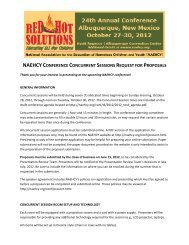The McKinney-Vento Act and Children and Youth ... - State of Michigan
The McKinney-Vento Act and Children and Youth ... - State of Michigan
The McKinney-Vento Act and Children and Youth ... - State of Michigan
You also want an ePaper? Increase the reach of your titles
YUMPU automatically turns print PDFs into web optimized ePapers that Google loves.
meeting the child’s unique needs, the <strong>McKinney</strong>-<strong>Vento</strong> <strong>Act</strong> does not relieve<br />
child welfare agencies <strong>of</strong> their responsibilities to support the educational<br />
success <strong>of</strong> their wards. From the initial step <strong>of</strong> defining awaiting foster care<br />
placement through all the complexities <strong>of</strong> implementing rights <strong>and</strong> services,<br />
child welfare <strong>and</strong> education administrators <strong>and</strong> staff, at both the state <strong>and</strong><br />
local levels, must operate in a coordinated, complementary fashion.<br />
To ensure that youth awaiting foster care placement receive all the rights<br />
<strong>and</strong> benefits to which they are entitled, the practitioners interviewed for<br />
this publication recommend several specific implementation strategies. <strong>The</strong><br />
following chart summarizes those strategies.<br />
STRATEGY<br />
Design <strong>and</strong> implement<br />
strategies to maximize<br />
school stability <strong>and</strong><br />
provide transportation.<br />
IMPLEMENTATION TIPS<br />
• Child welfare agencies should strive to find<br />
living placements near the child’s school <strong>of</strong><br />
origin, maintain continuity in the child’s living<br />
situations, <strong>and</strong> when living changes must occur,<br />
plan them such that placement changes occur at<br />
breaks in the school year.<br />
• Education <strong>and</strong> child welfare agencies can<br />
collaboratively determine the best plan for<br />
providing transportation <strong>and</strong> covering the costs,<br />
which may include sharing responsibility.<br />
• <strong>State</strong> <strong>and</strong> local child welfare <strong>and</strong> education<br />
agencies should seek additional funding for<br />
transportation, through grants or other state or<br />
local funding streams.<br />
Ensure that state <strong>and</strong><br />
local education <strong>and</strong> child<br />
welfare agencies have<br />
staff with sufficient training<br />
<strong>and</strong> capacity to ensure<br />
immediate enrollment,<br />
attendance, <strong>and</strong> services.<br />
• Child welfare agencies should identify education<br />
specialists within their agencies, with sufficient<br />
capacity <strong>and</strong> resources to attend to education<br />
issues.<br />
• <strong>State</strong> coordinators <strong>and</strong> school district homeless<br />
liaisons must have sufficient capacity <strong>and</strong><br />
resources to implement the <strong>McKinney</strong>-<strong>Vento</strong> <strong>Act</strong><br />
for all eligible youth, both those experiencing<br />
homelessness <strong>and</strong> those in out-<strong>of</strong>-home care.<br />
Strategies for Improving Educational Outcomes through School Stability 3














